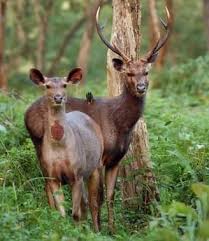Sambar Deer

- 29 Dec 2024
In News:
Three poachers were arrested for killing a sambar deer in the Daying Ering Memorial Wildlife Sanctuary (DEMWS), East Siang district, Arunachal Pradesh.
Action Taken:
- Poachers Arrested: The poachers were booked under the Wildlife Protection Act 1972 and Arms Act 1959. The seized articles were handed over to the police, and a FIR was registered.
- Sanctuary Protection Efforts: The Divisional Forest Officer (DFO) emphasized the need for intensified surveillance to prevent further hunting incidents. Public cooperation was urged to report such incidents for prompt action.
About Sambar Deer:
- Scientific Name: Rusa unicolor.
- Native Regions: Found across the Indian subcontinent and Southeast Asia.
- Other Names: Known as Jarao in Nepal and Four-eyed deer in China.
- IUCN Red List: Listed as Vulnerable.
Key Features:
- Size: Stands between 1.2–1.4 meters at the shoulder.
- Weight: Can reach up to 550 kg, making it the largest oriental deer.
- Coat: Dark brown with a ruff around the neck, and unspotted.
- Antlers: Male sambar bears long, rugged antlers with three points (tines).
- Behavior: Elusive, most active at dusk and night.
Habitat:
- Water Dependency: Always found near water sources.
- Habitat Range: Dry deciduous forests, rainforests, and mixed forests.
- Social Structure: Often found alone or in small groups.
About Daying Ering Memorial Wildlife Sanctuary (DEMWS):
- Location: Situated in East Siang district, Arunachal Pradesh.
- Established: Originally established as Lali Wildlife Sanctuary in 1976, renamed Daying Ering Memorial in 1986.
- Climate: Tropical, receiving both north-east and south-west monsoons.
- Waterways: Home to the Siang River, one of Arunachal's major rivers.
Flora:
- Vegetation: Composed mainly of riverine plains with a variety of thatch and grasses.
- Trees: Includes scattered patches of trees such as Termenelia myriocarpa, Dillenia indica, Albizia spp., and Bombax ceiba.
Fauna:
- Mammals: Includes Hog Deer, Wild Pig, Tiger, and Elephant.
- Birds: Over 150 species of birds, including endangered species like the White-Winged Wood Duck and Bengal Florican.
Sambar Deer (The Hindu)
- 08 Sep 2023
What is the News ?
Researchers recently spotted a rare sambar deer with leucism (partial white coloring) in the Cauvery Wildlife Sanctuary.
Facts About:
- Sambar deer, scientifically known as Rusa unicolor, are large deer native to the Indian subcontinent and Southeast Asia.
- They prefer to stay hidden and are most active during the evening and night.
- These deer can be found in a wide range of forest environments, including dry deciduous forests, rainforests, and mixed forests.
- One of their crucial roles in the ecosystem is seed dispersal within their natural habitats.
Distribution:
- They inhabit areas stretching from the foothills of the Himalayan Mountains across southern Asia, extending to the islands of Taiwan, Sumatra, and Borneo.
Threats they face:
- The main threats to Sambar deer are hunting and the encroachment of their natural habitat.
- In response to human hunting, they have adapted by becoming more active at night to avoid being hunted for trade and food.
Conservation status:
- According to the International Union for Conservation of Nature (IUCN), they are classified as 'Vulnerable.'
Under the Wildlife (Protection) Act of 1972, they are listed in Schedule-III for protection.
